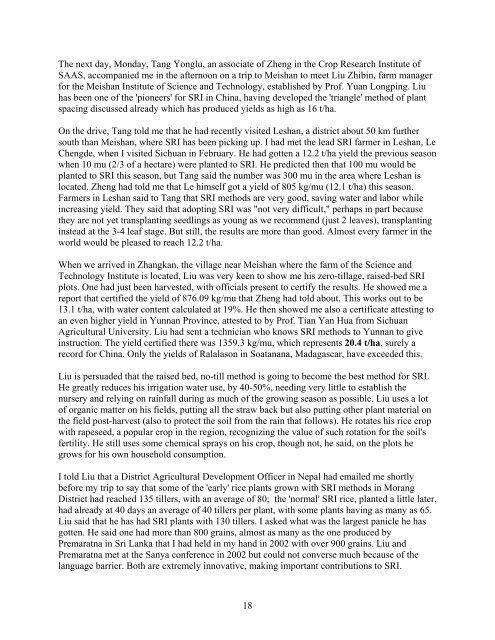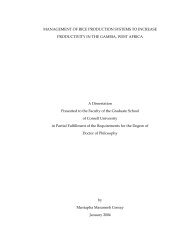Report from SRI China visit - The System of Rice Intensification ...
Report from SRI China visit - The System of Rice Intensification ...
Report from SRI China visit - The System of Rice Intensification ...
Create successful ePaper yourself
Turn your PDF publications into a flip-book with our unique Google optimized e-Paper software.
<strong>The</strong> next day, Monday, Tang Yonglu, an associate <strong>of</strong> Zheng in the Crop Research Institute <strong>of</strong><br />
SAAS, accompanied me in the afternoon on a trip to Meishan to meet Liu Zhibin, farm manager<br />
for the Meishan Institute <strong>of</strong> Science and Technology, established by Pr<strong>of</strong>. Yuan Longping. Liu<br />
has been one <strong>of</strong> the 'pioneers' for <strong>SRI</strong> in <strong>China</strong>, having developed the 'triangle' method <strong>of</strong> plant<br />
spacing discussed already which has produced yields as high as 16 t/ha.<br />
On the drive, Tang told me that he had recently <strong>visit</strong>ed Leshan, a district about 50 km further<br />
south than Meishan, where <strong>SRI</strong> has been picking up. I had met the lead <strong>SRI</strong> farmer in Leshan, Le<br />
Chengde, when I <strong>visit</strong>ed Sichuan in February. He had gotten a 12.2 t/ha yield the previous season<br />
when 10 mu (2/3 <strong>of</strong> a hectare) were planted to <strong>SRI</strong>. He predicted then that 100 mu would be<br />
planted to <strong>SRI</strong> this season, but Tang said the number was 300 mu in the area where Leshan is<br />
located. Zheng had told me that Le himself got a yield <strong>of</strong> 805 kg/mu (12.1 t/ha) this season.<br />
Farmers in Leshan said to Tang that <strong>SRI</strong> methods are very good, saving water and labor while<br />
increasing yield. <strong>The</strong>y said that adopting <strong>SRI</strong> was "not very difficult," perhaps in part because<br />
they are not yet transplanting seedlings as young as we recommend (just 2 leaves), transplanting<br />
instead at the 3-4 leaf stage. But still, the results are more than good. Almost every farmer in the<br />
world would be pleased to reach 12.2 t/ha.<br />
When we arrived in Zhangkan, the village near Meishan where the farm <strong>of</strong> the Science and<br />
Technology Institute is located, Liu was very keen to show me his zero-tillage, raised-bed <strong>SRI</strong><br />
plots. One had just been harvested, with <strong>of</strong>ficials present to certify the results. He showed me a<br />
report that certified the yield <strong>of</strong> 876.09 kg/mu that Zheng had told about. This works out to be<br />
13.1 t/ha, with water content calculated at 19%. He then showed me also a certificate attesting to<br />
an even higher yield in Yunnan Province, attested to by Pr<strong>of</strong>. Tian Yan Hua <strong>from</strong> Sichuan<br />
Agricultural University. Liu had sent a technician who knows <strong>SRI</strong> methods to Yunnan to give<br />
instruction. <strong>The</strong> yield certified there was 1359.3 kg/mu, which represents 20.4 t/ha, surely a<br />
record for <strong>China</strong>. Only the yields <strong>of</strong> Ralalason in Soatanana, Madagascar, have exceeded this.<br />
Liu is persuaded that the raised bed, no-till method is going to become the best method for <strong>SRI</strong>.<br />
He greatly reduces his irrigation water use, by 40-50%, needing very little to establish the<br />
nursery and relying on rainfall during as much <strong>of</strong> the growing season as possible. Liu uses a lot<br />
<strong>of</strong> organic matter on his fields, putting all the straw back but also putting other plant material on<br />
the field post-harvest (also to protect the soil <strong>from</strong> the rain that follows). He rotates his rice crop<br />
with rapeseed, a popular crop in the region, recognizing the value <strong>of</strong> such rotation for the soil's<br />
fertility. He still uses some chemical sprays on his crop, though not, he said, on the plots he<br />
grows for his own household consumption.<br />
I told Liu that a District Agricultural Development Officer in Nepal had emailed me shortly<br />
before my trip to say that some <strong>of</strong> the 'early' rice plants grown with <strong>SRI</strong> methods in Morang<br />
District had reached 135 tillers, with an average <strong>of</strong> 80; the 'normal' <strong>SRI</strong> rice, planted a little later,<br />
had already at 40 days an average <strong>of</strong> 40 tillers per plant, with some plants having as many as 65.<br />
Liu said that he has had <strong>SRI</strong> plants with 130 tillers. I asked what was the largest panicle he has<br />
gotten. He said one had more than 800 grains, almost as many as the one produced by<br />
Premaratna in Sri Lanka that I had held in my hand in 2002 with over 900 grains. Liu and<br />
Premaratna met at the Sanya conference in 2002 but could not converse much because <strong>of</strong> the<br />
language barrier. Both are extremely innovative, making important contributions to <strong>SRI</strong>.<br />
18
















